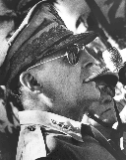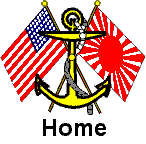|
 Warm Australian sunlight streamed through a dusty, small, third-class railway car window on Friday, March 20, 1942. A small locomotive with a 19th-century-style cowcatcher in front slowly pulled its old cars into the Adelaide Train Station and rattled to a stop. General Douglas MacArthur and his party now had completed the final leg of their perilous journey from Corregidor to Adelaide, Australia, a distance of over 2,500 miles. Warm Australian sunlight streamed through a dusty, small, third-class railway car window on Friday, March 20, 1942. A small locomotive with a 19th-century-style cowcatcher in front slowly pulled its old cars into the Adelaide Train Station and rattled to a stop. General Douglas MacArthur and his party now had completed the final leg of their perilous journey from Corregidor to Adelaide, Australia, a distance of over 2,500 miles.
A Presidential cable ordering MacArthurís evacuation from the Philippines had reached MacArthurís Philippine headquarters on Corregidor Island on February 22, 1942, placing the General in a real dilemma. He thought of resigning his commission, reenlisting as a private, and fighting with the Philippine guerrilla opposition. The temptation to disobey this order, therefore, was strong.
The General had a deep affection for the Philippines because he had served three tours of duty there and had to come to love it and its people almost as much as his native America. Still, he knew where his loyalties lay. Disobedience of a Presidential order would permanently stain his name. Though he had no choice but to obey and leave the Philippines, he vowed he would be back.
MacArthur had come to Australia to take command of all the Allied armed forces in the Southwest Pacific, leaving behind him thousands of American and Filipino soldiers and sailors to face the Japanese juggernaut. There was no doubt as to the outcome. These brave men and women would endure defeat, capture and tortuous years in Japanese prisoner-of-war camps, all matters that weighed heavily on his mind. 
Throngs of people waited as MacArthur left his railway compartment, and, notes in hand, opened the door to the rear platform. He stepped out, and presented himself to an eager crowd that greeted him with hope and enthusiasm. The press took pictures and got their notebooks ready. On the carís rear platform, MacArthur voiced his now immortal words:
The President of the United States ordered me to break through the Japanese lines for the purpose, as I understand it, of organizing the American offensive against Japan, a primary object of which is the relief of the Philippines. I came through and I shall return. 
And return he would. But, he had to first convince the American Joint Chiefs of Staff and, more importantly, President Roosevelt that the Philippines had to be invaded. After achieving dramatic victories in the Southwest Pacific, he met with Roosevelt and Nimitz in Hawaii in July 1944. Using his powerful presentation skills and charismatic personality, MacArthur convinced Roosevelt the Philippines had to be the path to cut the Japanese supply lines and achieve ultimate victory in the Pacific.
The crowning moment in his military career came on October 20, 1944 when stepped down a ramp of a landing craft with his staff and the President of the Philippines, Sergio OsmeŮa. MacArthur waded through the shallow water onto the beach and radioed a plea to the Philippine people to rise up and expel their Japanese tormentors from their beloved homeland. Less that three years ago, he made a promise to return. He had kept that promise. 
|



